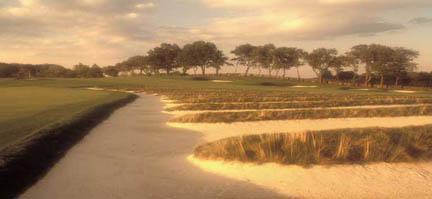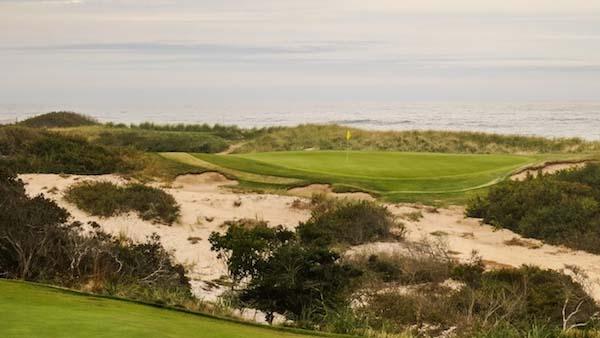 Whether it's a label on a consumer product or appliance, or part of an overall philosophy that reflects day-to-day golf course operations, going green is a phrase that has become ingrained into popular culture and vernacular.
Whether it's a label on a consumer product or appliance, or part of an overall philosophy that reflects day-to-day golf course operations, going green is a phrase that has become ingrained into popular culture and vernacular.Just what exactly "going green" means takes on a different connotation depending on who is talking about what, where they're talking about it and when.
At home, it can be as simple as adopting a recycling program, using energy-efficient appliances, buying organic produce or driving a hybrid car. In the workplace, it can be much more involved and might even include a formal environmental management system like those designed and implemented by companies such as ePar. For example, some college campuses have adopted, as part of an EMS, zero waste programs designed to eventually eliminate all solid waste through recycling and composting programs. For some in golf, going green can mean reducing inputs that help conserve water and other natural resources as well as minimize pesticide exposure.
"The term 'going green' in my eyes means preserving earth's natural characteristics," said Neil Mayberry, superintendent at The Country Club of New Orleans. "I feel like this can be done by reducing pollutants, such as carbon dioxide, and preserving natural vegetation (and) landscapes."
Going green has become, in a way, similar to golf industry growth initiatives designed to attract new golfers and coax existing customers to play more. In other words, large-scale industry initiatives mean little for those who are not participating in them and reaping the rewards. And because golf still is an industry that remains under the watchful eye of environmental groups, government agencies and a consumer public largely uneducated on how the industry truly operates, it is important in golf that individual facilities implement programs with locally quantifiable results.
"You have to change your entire way of thinking. You are not sorta pregnant, and you are not sorta interested in being kind to the environment," said Matt Crowther of Mink Meadows Golf Club on the island of Martha's Vineyard in Massachusetts. "It has to be a total buy-in. We may not be perfect, but we truly try with every part of the operation to protect the environment and do the best we can to put it first."
Although it wasn't always this way, the golf business is an industry that sets the standard for environmentalism, even if most don't know it.
For example, at Corral de Tierra Country Club near Monterey, California, superintendent Doug Ayres had been looking for ways to proactively cut expenses. Eventually, he reached an agreement with the club's restaurant, as well as with another nearby golf course to secure used cooking oil that equipment manager Brian Sjögren repurposes by brewing as much as 40 gallons of biodiesel per week. The program provides Ayres with a fuel source that is cleaner than traditional diesel and also results in an annual savings of more than $5,000 in fuel costs.
"I think if there is a real green movement in golf, it will be because the superintendent led the charge," said Matt Shaffer of Merion Golf Club in Ardmore, Pennsylvania. "Will we get the recognition? Perhaps not. But, if we don't lead the effort, the effort will be lost."
At Merion, Shaffer constantly is monitoring conditions and thinking of proactive ways to maximize playability with less input.
"Don't spray because the label says 14 to 21 days control," he said. "Don't spray again until you see some disease in one of your indicator spots.
"Think about growing a healthy plant, not a chemical-dependent plant."
Managing environmental stewardship while meeting customer demands is easier at some places than it is others. At Merion, as well as at Oakmont Country Club near Pittsburgh, maintaining a golf course that is tournament ready every day yet also strives for sustainability is nearly a 24/7/365 task.
"Going green, to me, relates to anything we can do while maintaining turfgrass to reduce our environmental footprint, promote environmental sustainability and exercise the utmost environmental responsibility," said John Zimmers of Oakmont.
"I feel strongly that our industry does it better than we ever have, and I am consistently intrigued by the new innovations and persistent progress that the turf industry has continued to make. I believe that this is often overlooked; however, in my opinion the turf industry is on the cutting edge of maintaining and preserving the environment."
Even in golf, going green can take on different meanings depending on geographic location. For example, although water conservation is taking on increasing importance on golf courses everywhere, it is likely to mean more at courses where water shortages are the norm.
"Water usage and water conservation are a huge part of ?going green,' " said Eddie Roach, superintendent at the Jimmie Austin Golf Course at the University of Oklahoma. "Watering turf with only the amounts needed for proper health instead of water for color can add up to major savings in water usage, electric usage, etc."
 For industry vendors, going green can apply to the products they manufacture and how they are made, or in the case of Aquatrols, how its products help customers achieve their environmental goals.
For industry vendors, going green can apply to the products they manufacture and how they are made, or in the case of Aquatrols, how its products help customers achieve their environmental goals."We need to balance the expectations of management, golfers, coaches and players with the realities of our world," said Nick Gadd, director of global marketing for Aquatrols.
"Going green does not mean eliminating the use of irrigation or chemical inputs altogether, but rather to optimize the way water and chemicals are used to grow healthy turf.
"Our goal is to help our customers increase their water use efficiency and reduce the total inputs needed to grow healthy plants."
According to published reports, the term "green" as it relates to environmentalism first was used in the early 1970s in Australia. There, green bans, or protests, were staged, often by labor union members, to protect areas of environmental, historical or cultural significance from development.
Since then, the term has been incorporated into social movements, manufacturing of energy-efficient products, social outlook and corporate philosophy.
"These days, it seems like you can't turn around without a company touting a new green initiative. What was once a fad has now become mandatory for manufacturers to not only maintain corporate responsibility, but to positively impact the bottom line," said Paul Hollis, executive vice president for Redexim North America. "From the perspective of an equipment manufacturer going green is a difficult task. We look inside our own organization to see what small improvements that we can make to save time, energy, resources, and in turn, help the environment."
When it comes to environmental stewardship initiatives, Paul Carter, CGCS, is an industry leader. A past winner of the GCSAA Environmental Leader in Golf Award, Carter runs a fleet of electric equipment at The Bear Trace at Harrison Bay. The golf course near Chattanooga Tennessee has won fans from around the world who have spent the past few years watching the nesting and parenting habits of bald eagles thanks to treetop cameras that stream live video. But mention going green, and even Carter admits the meaning can be murky.
"I agree that 'going green' in general terms can mean any number of things, and a lot of companies use the term just because they might think it looks good on their product, or they think it might help them sell more units," Carter said. "When the environmental movement started, (the term) 'going green' had, in my opinion, a connotation of being completely earth friendly and self sufficient/sustaining. I felt like the movement made you feel that if you weren't living in the mountains and living off the land that you were not going green. As thing
s have calmed down and more people have accepted the environmental ideals I think going green means more about what you can and are willing to do to protect the environment and reduce the consumption of resources."
At The Bear Trace going green also means making decisions based on how they will affect local wildlife. Since the course is located inside a state park, how management decisions affect local fauna mean more here than at most golf courses.
"Going green to me means making sure that each decision we make in terms of growing turf on our golf course is done with the natural inhabitants of the land in mind," he said. "Are our actions going to positively or negatively impact the wildlife that call the golf course home? We try to find every way possible to reduce our use of natural resources and reduce our impact on the environment as a whole."
Thankfully, much has changed since then, said Gregg Munshaw, Ph.D., of the University of Kentucky.
"One of the things I was challenged with when I accepted my current position was to improve the green knowledge of everyone involved in turf management throughout the state," Munshaw said. "Much of our research these days is looking at ways to minimize the impact on the environment. Data from our research as well as from others is presented at various meetings around the state as well as in the classroom. When I was teaching at Miss. State I would challenge students to think every day about how their decisions would impact the environment. Good environmental choices make the whole industry look good while poor environmental choices make us all look bad."
Indeed, going green often can have a paradoxical meaning that refers not to the color of the turf, but another kind of green entirely.
 "Oddly enough, as it relates to turf maintenance, going green can mean going brown," said John Genovesi, CGCS at the Maidstone Club on New York's Long Island. "Trying to use the minimal amounts of resources like water and fertilizer may not give you a course that's green in color but will yield a course that plays well and puts some green back into your budget."
"Oddly enough, as it relates to turf maintenance, going green can mean going brown," said John Genovesi, CGCS at the Maidstone Club on New York's Long Island. "Trying to use the minimal amounts of resources like water and fertilizer may not give you a course that's green in color but will yield a course that plays well and puts some green back into your budget."There was a time in golf, however, when there was not a thought to going green, other than keeping courses green at all costs.
"Many people, I think, think of ?green' in the turf industry as what we should be striving for from a visual or aesthetic standpoint, and that was how it was when I entered the business some 20-plus years ago," Carter said. "Everything was mowed, fertilized, and weed controlled on almost every acre on property. While that was good for the golfer who wanted to find his ball no matter where he hit it, it was not good for the environment.
"From over fertilization, to overuse of water and fuel, to water contamination from soil particle runoff, chemical and fertilizer residue, and petroleum product residue, the golf course maintenance industry did not do ourselves any favors during this time. I am glad that it has changed over the past 10 to 15 years and we, as an industry, are becoming more aware of how our actions and choices affect all aspects of the environment."
One thing many in the industry can agree upon is that it is incumbent on superintendents to assume the lead in the green movement, and pass along that knowledge to others, including future greenkeepers.
"I believe that ensuring we are green is a huge responsibility, especially when managing a historic site like Oakmont Country Club," Zimmers said. "I believe that this role also includes teaching and training upcoming professionals in the turf industry. It is also my role to manage their safety, teach them that gravity of environmental responsibility, and teach them the financial aspect of proper environmental management."
That does not happen overnight. Instead, said Maidstone's Genovesi, it involves changing the way people think and reinforcing it daily.
"As manager of our grounds department," he said, "I believe my greatest role does not revolve around a specific maintenance task but rather in establishing a culture among our staff that emphasizes environmental awareness as a guiding principle when we set out to accomplish our daily tasks."

